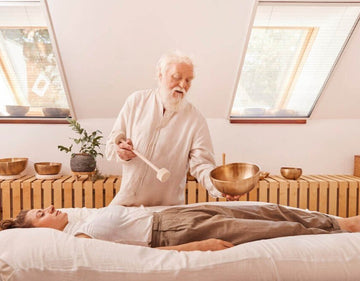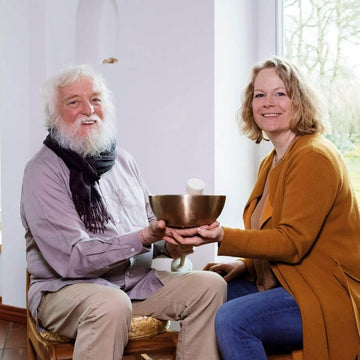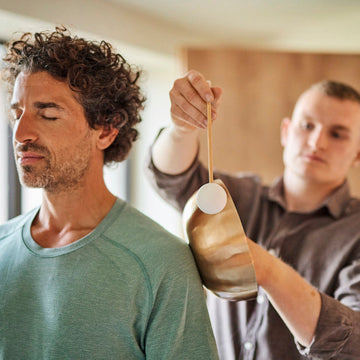
Key points at a glance
- The perception of sounds takes practice: the more often you try a sound exercise, the better you will feel the sound with your whole body.
- The exercises are about letting go completely - the sounds help you to do this and guide you inwards.
- You can also perform the singing bowl exercise wonderfully with children and as an evening ritual.
- Sound exercises in the evening can help you fall asleep and sleep through the night.
Play, listen to and perceive Singing Bowls
By striking or playing a Singing Bowl, we begin to listen. Listening is more than hearing; it's perceiving the sounds with your whole body. During the following singing bowl exercises, fully focus on the sounds, bodily sensations, thoughts, and feelings. Listening to the sounds guides you inward to a soothing stillness, while what's happening externally fades into the background.
Singing bowl exercise 1: How to play your singing bowl and find inner peace
This exercise is a type of sound meditation. Make yourself comfortable and place the Peter Hess® Universal Bowl, or any other high-quality Singing Bowl, directly in front of you on a cushion or other vibration-friendly surface.
Strike and listen to the nuances of sound
Now strike your Singing Bowl gently and perceive its sound. Perhaps you close your eyes to fully engage with the sounds. Can you hear the different nuances? The different high and low tones together create a wonderful, overtone-rich soundscape.
Feel the sound
Listen to the sound with your whole body and become one with it. You may feel how your body is touched by the sound vibrations. Can you feel the sound?
Let your breathing become calmer.
After a while, you can play your Singing Bowl again. As you listen to the rising and falling sounds, your breathing will become calmer, deeper, and more relaxed. If you like, consciously take a few deep breaths. The silence after each sound allows a pleasant calmness to arise within you. Enjoy the sounds for as long as you like and perceive the relaxing, harmonizing effect.
Feel afterwards
Now, put the Singing Bowl and mallet aside and take a moment to feel the effects with your eyes closed. Perhaps you can still feel the sounds even though they have faded away – they continue to resonate within you. How do you feel now, what is going on inside you, how do you perceive your body? Take your time and simply observe, without judgment.
Conclusion
Finally, take a few more deep breaths, stretch and reach.
Good to know
If you don't feel the sounds in all areas of your body during the first practice, that's perfectly fine. Like so much in life, perceiving the sounds is a matter of practice. Therefore, we recommend performing the sound exercises regularly – preferably daily, but for a shorter duration.
Singing bowl exercise 2: Experiencing the sounds of the singing bowl through the hand reflex zones
In this exercise, try to focus your attention completely on the area of the body being addressed. This way you can experience how the sound vibrations gradually spread throughout your body. When used regularly, this small sound meditation can be a valuable companion in everyday life. The entire body is stimulated via the reflex zones. This singing bowl exercise is particularly helpful in preventing stress and overexertion at an early stage, or in regularly reducing them and strengthening your own health.
Preparation
Make yourself comfortable in a seated position. Open the palm of your right hand, with the palm facing upwards. If it is more comfortable for you, you can also place your hand on a cushion. Now, position the Singing Bowl on your palm.
Strike the Singing Bowl
Gently strike your Singing Bowl from the outside at the upper edge. First, simply listen to the sounds. In the next step, expand your perception to include feeling. Consciously perceive the vibrations of the Singing Bowl in your palm. You feel the delicate vibrations of the resonating bowl on your palm and direct your full attention to it. The vibrations move gently over the skin and through the palm.
Feel the vibrations throughout your body
Now expand your attention to your entire body: let the sounds flow through it. Feel how the Singing Bowl vibrations spread from your palm to your right wrist, and then to your right forearm, to your right elbow joint, to your right upper arm, to your right shoulder joint, to the neck area, and finally to your entire body.
Change sides
Take enough time to perceive the sounds in your body. When you are ready, position the Singing Bowl on your left hand and repeat the process as with the right hand.
Feel afterwards
Now, put the Singing Bowl and mallet aside and take a moment to feel the effects with your eyes closed. If you like, consciously take a few deep breaths. Be completely with yourself: How do you feel, what is going on inside you, how do you perceive your body?
Conclusion
Finally, take a few more deep breaths, stretch and reach. Return to everyday life at your own pace.
Would you like even more detailed instructions for a sound exercise? In this video, we show you step by step how you can give yourself a sound massage for your hands at home.
Singing bowl exercise 3: Sound relaxation for the abdomen
The abdominal area is a particularly sensitive area of the body that can react to stressful situations with digestive problems, abdominal or stomach pain. Playing Singing Bowls creates sounds that are a wonderful way to gently relax the abdomen.
The exercise for sound relaxation for the abdomen has also proven particularly effective for menstrual discomfort.
Preparation
Lie loosely on your back and make yourself as comfortable as possible. Position the Singing Bowl on the solar plexus chakra. This is about a hand's breadth above the navel. Make sure that your head and the arm with which you want to strike the Singing Bowl are well supported so that there are no unnecessary efforts or tensions.
Strike and play the Singing Bowl
Now gently strike the Singing Bowl from the outside at the upper edge. If you like, close your eyes and direct your attention entirely to your solar plexus chakra. Notice how the sounds gently massage this area and how a pleasant relaxation gradually spreads from there. Breathe deeply and repeat this process several times.
Move the Singing Bowl
After you have struck the Singing Bowl on your solar plexus chakra a few times, slide it a little further down onto your lower abdomen so that the Singing Bowl touches the pubic bone. Now strike the bowl gently here a few times. Take your time between the strikes and feel the spreading vibration. Then slide the Singing Bowl back to the solar plexus chakra and strike it there again about three to five times.
Feel afterwards
How do you feel now and how are you doing? Simply perceive without judging. Put the Singing Bowl and mallet aside and take a moment to feel the effects with your eyes closed. If you like, consciously take a few deep breaths. Perhaps you can still feel the sounds even though the audible sound has already faded away.
Conclusion
Finally, stretch out extensively before you open your eyes and arrive completely in the here and now with your attention.

Note
The lower abdomen usually reacts particularly sensitively to the sounds. The gentle Singing Bowl vibrations spread over the skin, the organs, the tissue, the body fluids and body cavities. In the process, these experience a gentle massage and come (back) into motion.
Therefore, this singing bowl exercise can stimulate digestion and relieve cramp-like symptoms, such as menstrual discomfort. Stress, which often feels like a stone in the stomach, can be gradually reduced.
Singing bowl exercise 4: Playing singing bowl in the evening – ritual and sleep aid
The sounds of the Singing Bowl always have a holistic effect on the body, mind and soul, and ensure that circling thoughts come to rest. After a stressful day, sound relaxation for the abdomen - as in exercise 3 - is a good way to fall asleep and stay asleep more easily. As you listen to the sounds and perceive the vibrations, the burden of everyday life gradually falls away from you.
You can use this evening ritual to let the images of the day pass by without dwelling on them. Playing the Singing Bowl helps you to do this as a neutral observer. This allows you to see what went particularly well and was beautiful - and also what was not so pleasant and what you might want to do differently next time. Then allow your thoughts to slowly calm down so that your body relaxes more and more. It is quite possible that you will drift into a deep sleep immediately after the exercise.
The sounds of the Singing Bowl always have a holistic effect on the body, mind and soul, and ensure that circling thoughts come to rest. After a stressful day, sound relaxation for the abdomen - as in exercise 3 - is a good way to fall asleep and stay asleep more easily. As you listen to the sounds and perceive the vibrations, the burden of everyday life gradually falls away from you.
You can use this evening ritual to let the images of the day pass by without dwelling on them. Playing the Singing Bowl helps you to do this as a neutral observer. This allows you to see what went particularly well and was beautiful - and also what was not so pleasant and what you might want to do differently next time. Then allow your thoughts to slowly calm down so that your body relaxes more and more. It is quite possible that you will drift into a deep sleep immediately after the exercise.
The sounds in the evening can also be used wonderfully with children as a bedtime ritual. You can review the day together with them or accompany the bedtime story with the sounds. There are many possibilities here.
Singing bowl exercise 5: foot bath with singing bowl
A foot bath with sound can be a very special experience. The vibrations of the Singing Bowl spread evenly over the water and flow from there into your feet and legs. For this very gentle way of absorbing the sounds, you need a tub that is large enough to hold both your feet and a Singing Bowl.
This Singing Bowl exercise can help you to ground yourself and relax and recharge your entire body with the power of the sounds.
Preparation
Fill the tub about halfway with warm water so that the water reaches over your ankles. Optionally add a few drops of pure essential oil. Lavender or peppermint oil, for example, are suitable for relaxing the feet and legs.
Placing the Singing Bowl
Place the tub in front of a chair and make yourself comfortable. You should be able to place your feet in the warm water in a relaxed manner. Now place the Singing Bowl on the surface of the water, preferably in front of or between your feet.
Generating sound
Take your Singing Bowl mallet and gently strike the Singing Bowl. Observe for a moment how the sound vibrations spread in the water and reach your legs.
Relax and perceive
Now close your eyes and feel how the sounds reach your body and gently massage it, starting from your feet and rising upwards. Imagine the sounds flowing through you like water, carefully making their way through your body. Strike the Singing Bowl again as soon as the sound fades. Repeat this five to six times and enjoy the pleasant relaxation.
Ending the exercise
Let the vibrations slowly fade away and feel the effects for a few breaths. When you are ready, open your eyes, stretch and reach, take your feet out of the water and dry them. Remove the Singing Bowl from the water and dry it carefully as well.

Playing the gong and experiencing deep relaxation
Similar to the Singing Bowl exercises, you can also play a gong to achieve deep relaxation. The gong now has a high status in sound and music therapy. This form of therapy has received increasing attention in recent years, as the experience of frequencies enables stress reduction, deep relaxation, overcoming fears and being in harmony with oneself.
Good to know
Like Singing Bowls, the gong has the advantage that the frequencies - especially the overtones - develop and spread slowly and do not fade away quickly as with other instruments. This means that these frequencies can be felt and internalised better with the whole body. Those who engage with it can experience balance and inner peace by playing the gong.
Gong bath
Several gongs are usually used for this exercise. It is usually offered as part of a course for several participants or as an individual session. The gong bath is an intensive form of sound therapy. The aim of this meditation is to leave everyday life with all its worries and stress behind. During a gong bath, you immerse yourself in a deeply relaxed sound experience, in a sea of sound, in which the participants are enveloped by the sounds of various gongs and other original instruments.
For a gong bath, lie down as centrally as possible between the gongs on a comfortable mat, close your eyes and let the unique sounds of the gongs work their magic on you. In this way, you will be transported to a space of silence and inspiration within a very short time. The sound waves of the gongs are so strong that you can feel them all over your body. With each strike of the gong, the reverberation of the gong adds up to a sound space that carries the listeners away.
Learn to play the gong
Not only professional musicians in the orchestra learn to play a gong, but also yoga and meditation teachers, alternative practitioners, therapists and private individuals who are interested in the voluminous and fascinating instrument. If you would like to learn to play the gong in a seminar, you will usually also learn a lot about the meditative basic attitude, about the sound qualities and expressive possibilities of the gong. In the Gong Basics course at the Peter Hess® Institute you will also learn a way of playing for a targeted tapestry of sound in sound meditations and sound journeys.
Anyone who learns to play a gong also learns a lot about the tradition of the gong and is introduced to the playing techniques of various types of gong. In addition, you will learn about the numerous possible applications, especially in the therapeutic field. It is particularly important when playing the gong to learn how and where the respective tones are produced on the gong and what nuances and facets the sounds have. It is also exciting to find out how to let sounds swell and then gently fade away again.
The Peter Hess® Institute offers you numerous possibilities to use your gong, whether as part of a sound massage, imagery journey or during the Experimental Gong Experience. Take a look at the various (online) seminars and workshops or enter the keyword “Gong” in the seminar search.
The advantages of a seminar to learn to play a gong:
- Get to know the meditative basic attitude and history of the gong
- Experience different possible applications
- Experience how the gong helps to let go of everyday life and relax
- Listen to and play different gongs
- Feel your way and try it out under guidance
- Learn the tapestry of sound for sound meditations and sound journeys
- Accompanying Sound Massages







